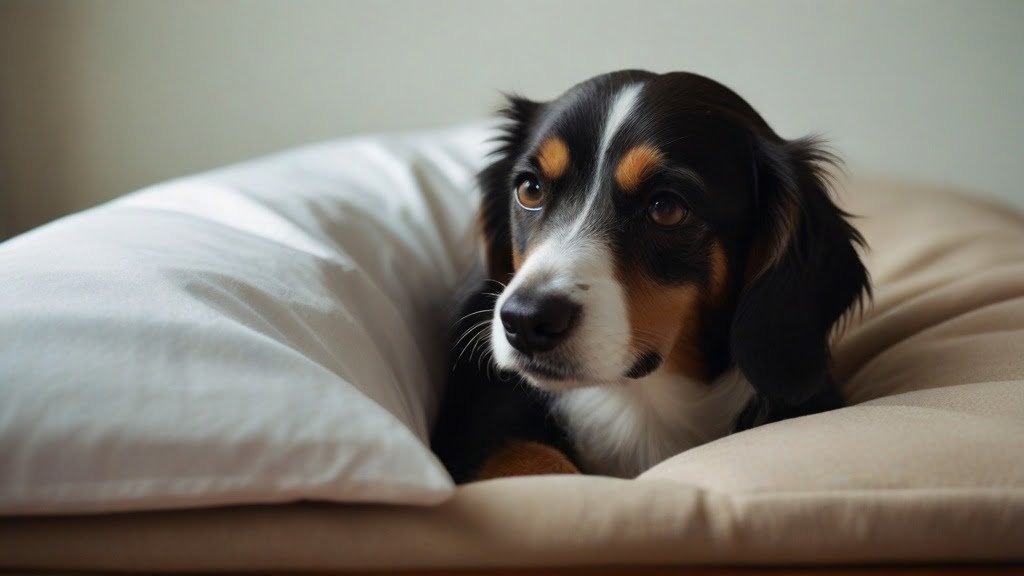If your dog has parvovirus, getting them to a vet right away is key. Parvo spreads quickly and could be deadly. It’s better for your dog to stay in the hospital if they can. There, they’ll get IV fluids, medicines for vomiting, and sometimes blood. For less severe cases, home care might work. Your vet should guide you. Remember, parvo is easily spread, so your vet can help keep your dog isolated. Ask them about warning signs that mean your dog needs immediate vet care.
Key Takeaways:
- Parvo is a highly contagious and potentially fatal disease in dogs.
- Seek veterinary treatment immediately for an infected dog.
- Veterinary hospitalization is recommended for severe cases of parvo.
- Treatment may include IV fluids, medications, and blood transfusions.
- Mild to moderately sick dogs can be treated at home under veterinary supervision.
Rehydrating Your Dog with Subcutaneous Fluids
When a dog gets parvo, they often vomit severely and get dehydrated. It’s hard for them to keep fluids down. This can be dangerous for their health. Subcutaneous fluids help by hydrating them under the skin.
It’s important to talk to your vet about the right fluids. They might suggest isotonic sodium chloride or lactated Ringer solution. Your vet will also help with how much to give and how often. Subcutaneous fluids are a good choice if the dog can’t get IV fluids.
If the veterinarian allows, you can administer subcutaneous fluids at home. They will give you everything you need and show you how to do it. Following their advice and keeping a close eye on your dog is key.
Advantages of Subcutaneous Fluids for Rehydration
Giving fluids this way has several benefits:
- Cost-efficiency: It’s cheaper than staying in the hospital or getting IV fluids from a vet.
- Convenience: It’s a good option when going to the hospital isn’t possible. You can do it at home.
- Continuous hydration: This method keeps your dog hydrated steadily.
Prevention through Vaccination
Prevention is always better than treatment. Vaccinating your dog against parvo is crucial. It stops them from getting very sick. Make sure to keep up with your vet’s vaccination plan.
Administering Fluids to Your Dog

Giving your dog fluids under the skin is key when they have parvo. It helps keep them hydrated and speeds up their healing. Here’s a simple guide to give fluids to your dog:
- First, connect the tube to the fluid bag. Close the clamps to stop any leaks.
- Hang the bag so it’s higher than your dog. This lets the fluids move down because of gravity.
- Get rid of any air in the tube. This step keeps your dog from feeling discomfort.
- Then, add the needle to the tube. Always keep the tube’s end clean.
- Make sure your dog is calm. Inject the fluids slowly between their shoulder blades.
- Take the needle off when you’re done and put it in the right place.
Always listen to what your vet says about how much and how often to give fluids. But, a rule of thumb is to give 40ml per kilogram every 8 hours. This keeps your dog hydrated all day.
Proper Fluid Administration Tips:
- Talk to your vet before you start. Do as they tell you.
- Make sure everything is clean. Wipe the injection spot. Use clean tools.
- Watch how your dog acts when you give them fluids. Stop if they seem uncomfortable.
- Write down when and how much fluid you give. This helps your vet see how your dog is doing.
Fluids are crucial for a dog with parvo. With the right steps and your vet’s advice, you’re helping your dog heal. Working with your vet can improve your dog’s recovery chances.
Providing Oral Fluids and Addressing Diarrhea
When your dog stops vomiting, you can start giving them oral fluids. This will help keep them hydrated. Wait 6-12 hours after their last vomit to give them any fluids. Use a catheter syringe to control the amount. This prevents overhydrating.
Signs of parvo in dogs: If your dog has parvo, they might vomit a lot, have diarrhea, and seem very tired. They may also not want to eat or drink. If you see these signs, get them to a vet right away.
To help with diarrhea from parvo, avoid over-the-counter treatments. Instead, try natural remedies. Things like slippery elm bark, probiotics, and bone broth can be beneficial without stopping the body’s natural healing.
Parvo Recovery Timeline:
The time it takes for a dog to recover from parvo varies. They might get better in a few days or a few weeks. Always follow your vet’s advice and keep watching your dog closely.
During recovery, keep your dog away from others to prevent spreading the virus. Clean their things well. Wait for your vet to say it’s okay before letting them near other dogs.
| Stage of Recovery | Timeline |
|---|---|
| Initial improvement | Within a few days of treatment |
| Eating solid food | 1-2 weeks |
| Regaining weight | 2-3 weeks |
| Full recovery | Several weeks |
Support your dog’s recovery with good care, fluids, and vet help. Be patient as they heal. Follow what your vet says about medicine, diet, and rest. With your love and proper care, your dog can beat parvo and get healthy again.
Conclusion
Caring for a dog with parvo means getting them to a vet right away. But, you can also help in their recovery at home. It’s crucial to keep them hydrated with fluids under their skin to fight dehydration. Do this with your vet’s advice to see the best results. Once they can hold down liquids, switch to drinking on their own.
Help stop diarrhea with natural ways and avoid treatments that hide the symptoms. This will help their body to heal. The time it takes for a dog to get better from parvo can change. It depends on how sick they were and how fast they got treatment.
Talk to your vet a lot during the healing time. They will give you the right steps to follow. Even though parvo can be very harmful, taking care of your dog and using the right treatments can make them more likely to survive.
Remember, use any home remedies for parvo under the eye of a vet. Acting fast and following treatment steps is key to helping your dog beat this tough sickness. With proper care, your dog can move past parvo and start feeling happy and healthy again.
FAQ
How do I take care of a dog with parvo?
If your dog has parvovirus, quick veterinary care is essential. Parvo is both highly contagious and can be deadly for dogs. It’s best if a veterinary hospital treats your dog. This treatment often needs IV fluids and medications for vomiting and nausea, sometimes even blood transfusions.
You might treat a mildly sick dog at home with your vet’s help. Always ask your vet about the signs that mean you should go back to the hospital.
How can I rehydrate my dog with subcutaneous fluids?
Dogs with parvo can’t keep fluids down and get dehydrated from vomiting a lot. Subcutaneous fluids can be given to help hydrate the dog. These go under the dog’s skin and help them get fluids back more safely.
Always consult your vet on what fluids to use and how much. They might even give you a guide to use if care is at home. If it’s severe, the more effective IV fluids in the hospital might be necessary.
How do I administer fluids to my dog?
To give your dog subcutaneous fluids, first attach the tube to the fluid bag. Make sure the tube’s clamps are closed. Keep the bag above the dog to use gravity to help. Ensure no air is in the tube to prevent discomfort.
Introduce the needle into the dog’s skin between the shoulder blades. After giving the fluids, take out the needle safely. Your vet will tell you how much fluid to give and how often. As a rule, 40ml per 1kg every 8 hours is a standard dose.
How do I provide oral fluids to my dog and address diarrhea?
When your dog can drink without vomiting, start giving them fluids by mouth. An electrolyte solution for dogs is a good choice. Waiting 6 to 12 hours without vomiting is a good sign to start.
Use a catheter syringe to give small amounts at a time. This helps avoid overwhelming your dog’s gut. Natural remedies are best for diarrhea, avoiding any over-the-counter products.
What is the recovery timeline and survival rate for dogs with parvo?
The recovery time and chance of your dog surviving parvo depend on how bad it gets and how fast you act. Working closely with your vet is key during the recovery phase. Always follow your vet’s advice on care and check-ups.









Leave a Reply